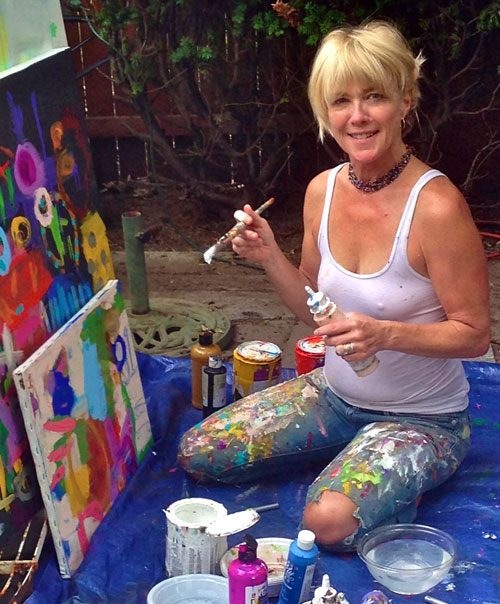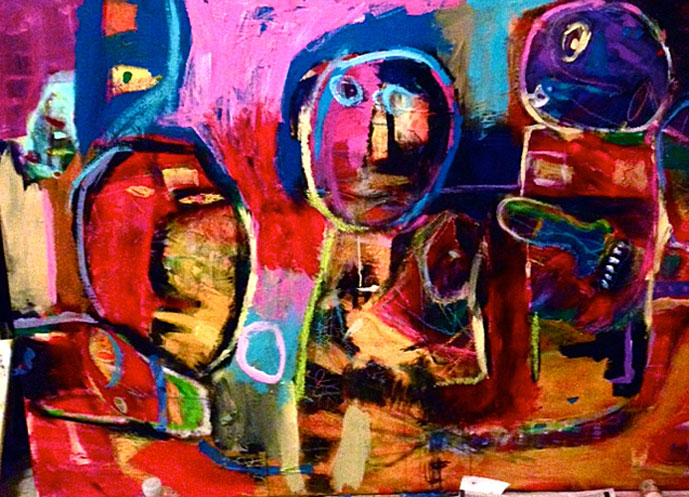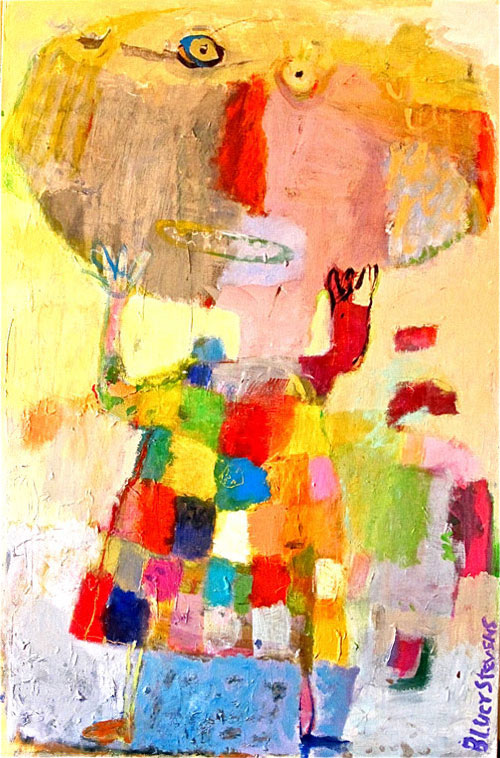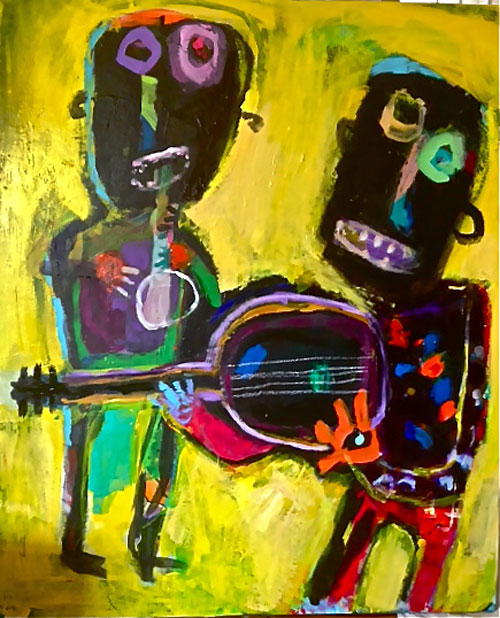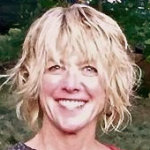Art, // April 15, 2018
B. Lucy Stevens — ARTIST
Interview with artist B. Lucy Stevens —
1. Who are you and what do you do?
I’m a self-taught artist living in Providence, Rhode Island, home to lots of artists and the famous Rhode Island School of Design. My favorite thing, though, is the Big Blue Bug. It’s this giant fiberglass termite– an ad for a pest control company– that gazes out over the city from the top of a downtown building. I love the bug. I swear it’s why I moved here. Sometimes I’m called an “outsider” artist, there’s not even agreement about what that means. In the sense that I’m not a product of art school and am doing my thing outside the “mainstream” art world, I guess I can go with that. I paint and draw and make sculptures from found objects. A children’s picture book I wrote and illustrated, “The Adventures of AlphaBete,” will soon hit the virtual bookshelves on Amazon. My paintings have won awards and are in several galleries in the U.S. and I’ve had work exhibited in Europe and the U.K., and I am in private collections around the globe. I doodle obsessively and recently was one of the winners of an international doodle contest sponsored by the online art gallery High Art Fridays.
2. Why art?
Because I can’t help it! It’s what I’m good at. If I could do something else I would. I had blood drawn the other day and for a moment the thought of being a phlebotomist struck me as appealing — you know, steady hours, steady, paycheck, etc. Years ago, though, I was a newspaper reporter, a job I loved. After my kids came along I got an MFA in creative writing and wrote fiction, short stories and such, and I taught writing at a nearby college. I loved teaching, too. But ten years ago something happened. I don’t know what, but my brain changed. Words stopped being interesting to me. Making art comes more naturally to me than writing, and I’m able to express something with images that I wasn’t able to convey with words. Now I look at my files of newspaper articles and class notes, and I think, Who was that person?
3. What is your earliest memory of wanting to be an artist?
In first grade they asked us what we wanted to be when we grew up, and I said artist and forest fire fighter. But I lost touch with the artist idea as I got older. No one I knew was an artist and there were no art museums or galleries where I lived in New Hampshire. The few times I took an art class I got discouraged because compared to other kids I wasn’t particularly talented at drawing things realistically. I wasn’t like this kid in my class, who got first prize for his perfectly rendered drawing of an earthworm magnified 100 times. I knew I couldn’t do that. Now I think, why would you even want to?
I hope it’s okay if quote Jean duBuffet here.
“It seems to me that to set oneself to inventory the true measurements of things is a practice without the slightest value. What to me seems interesting is to recover in the representation of an object or person the whole complex set of impressions we receive as we see it in everyday life, the manner in which it has touched our sensibility and the forms it assumes in our memory.”
4. What are your favorite subject(s) and media(s)?
People and their stories are endlessly interesting to me. I am fascinated by the idea that inside each one of us swirls a rich universe of emotions, experiences, thoughts and memories. I want to know these stories and find a way to express them. The other day I stopped and talked to a panhandler. He was a skinny African-American man with only a few teeth wearing a blue windbreaker and a black knit hat. His cardboard sign said “Too Ugly To Prostitute, Won’t Steal.” He told me his name was Dean and that he takes medication to stop the voices in his head. The medication worked, he said, and he is grateful for that. Dean used to work for an amusement company and traveled around the country with them setting up roller coasters and Ferris wheels, which explains why he doesn’t have a wife or family. On days he makes enough money he spends the night in a motel in the next town over. He takes Bus Number 6 to get there. Other nights he’s out on the streets.
I want to paint this.
5. How do you work and approach your subject?
I used to have a plan before I embarked on a painting. My approach now is intuitive. I just start brushing and smearing paint around and then stand back and look at it and see what happens. Something always does. Figures appear from the chaos, mostly people and animals, and they start to tell me a story. I love the surprise of it and what I learn from them. I have bad eyes. I’m extremely myopic and astigmatic, and something else I have no idea how to spell. Plus I have this weird eye disease that causes my eye muscles to freeze up so my vision is distorted. I see things other people don’t and I’m blind to things that are right in front of my nose. I think my eyesight plays a role in my painting.
6. What are your favorite art work(s), artist(s)?
Jean Dubuffet. He thought the everyday life of ordinary people contained more art and poetry than academic study or “great painting.” Primitive art moves me very much and children’s art, the spontaneity, the freedom of it. I spent three years doing art with a group of adults with intellectual disabilities at Resources for Human Development Rhode Island, and their art blew me away. They have no clue about rules or traditions, they aren’t trying to impress anyone. What poured out of them was a pure expression of their souls, strange and beautiful and true. I was supposed to be teaching them, but they taught me. Their work was an inspiration.
7. What are the best responses you have had to your work?
Kind of related to that. At a solo show I had in Providence, the gallery owner told me that a woman came up to her and asked if my paintings were made by a kid. The gallery owner told her no. “Ohhhhhh,” the woman said, and then whispered, “Is she retarded?” Aside from the r-word part, I took her comment as a compliment.
I’ve seen someone cry looking at my work. (Not that it’s all sad!) Once a woman took one look at a painting and came over and gave me a huge hug. She said, “I don’t even know you but I have to hug you!”
A woman who bought one of my paintings told me it helped her get through breast cancer. I know, right?
It was a thrill to see my paintings a few years ago in the window of a gallery in Paris. The gallery attracted an international clientele and the woman who ran it would write to tell me who bought what painting and what country they were from. It’s gratifying to that my work is in homes, and collections all around the world.
8. What do you like about your work?
Someone wrote me the other day. She said, “I love your colors and expressiveness. Very open and free.” I like that my paintings make people feel something. That it touches people.
9. What advice would you give to other artists?
I didn’t think I had any advice, but I guess I do. Enjoy the process. Have fun. Don’t take it too seriously And don’t get all hung up about the final product. Do not, for Heaven’s sake, worry about doing something “wrong,” about making a “mistake.” Embrace mistakes. Often they turn into something wonderful. Anyway, if you’re working with acrylics, which dry quickly, you can just paint over what you don’t like, and that’s cool because then you have lots of layers in your painting which make things more interesting. Don’t compare yourself to other artists but learn from the ones you like. If you dig the way Pierre Bonnard uses color, study his paintings, figure out what he did and then copy it. Yes, I am encouraging you to steal. All artists do.
10. Where do you see yourself in 5-10 years?
I’ve lived my whole life in New England, where it’s cold for more than half the year (yesterday was April 5 and it snowed ), so I plan to be somewhere warm and sunny, California maybe, with a spacious light-filled studio attached to my house and a swimming pool right outside the door. I’ll still be learning and experimenting and excited about making art. I’d love to do some public projects and collaborate with other artists. I believe that making art is an act of healing and improves lives. I see myself leading art workshops at hospitals and nursing homes and also for people who simply wish to tap into their own creativity but don’t know where to start. I’ll travel around the world doing workshops and shows, and then come home to sunny California, strip off my clothes and jump into my pool.
LINKS —
Website: https://blucystevens.com
Facebook: https://www.facebook.com/blucystevens
Blog: https://blucystevens.com/2017/11/01/one-night-in-paris
Instagram: blucystevens
More on Outsider Art: https://rawvision.com/about/what-is-outsider-art



